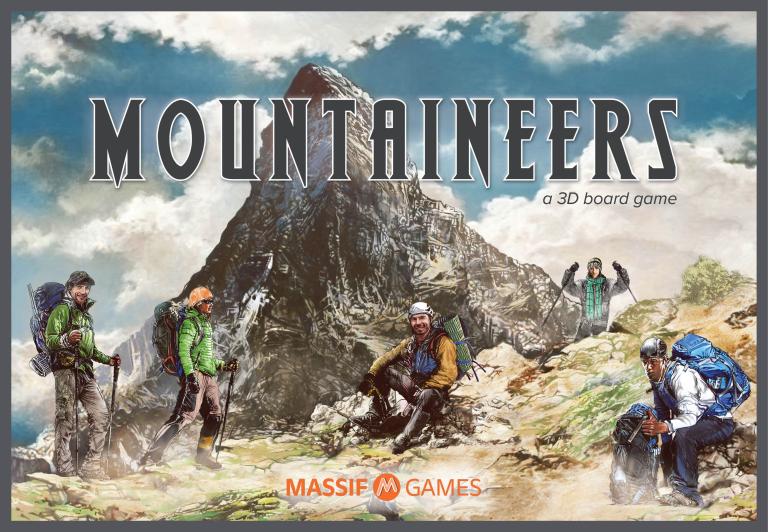Mountaineers

Mountaineers
Mountaineers is a strategic board game in which 1-6 players compete against each other and AI climbers to earn climbing points (victory points) as they maneuver around a 18 in./45 cm tall rotating 3D modular game board. The theme of Mountaineers is lighthearted and fun, primarily focused on competitive route finding, resource management, character building and upgrades, while challenging players to react to various exciting (and sometimes comical) events that occur on the mountain.
Strategy during both set-up and game play is important. At the beginning of a game, players need to choose four climbing routes, one character, and a starting position that work well together, in order to earn the maximum amount of points possible. However, as the game progresses, the mountain terrains fill up, making it more difficult to complete certain climbing routes. Additionally, various mountain conditions change (once per player), and event cards (drawn on each turn) require players to adapt their strategy, change their climbing routes, and purchase various combinations of gear upgrades to continue climbing.
Resource management is important as players start with a limited number of thirty route markers and will on average draw only sixty supply tokens during a game. Depending on the game and the various difficulty of event cards used, players have to balance how often they spend supplies and route markers in order to climb efficiently and complete routes. Climbing strategy is also important. Players must be careful in what order they complete routes, how they maneuver on the mountain, and whether or not they pay extra to "lock in" certain route markers to avoid sabotage by other players.
A typical turn involves drawing an event card, resolving the conditions of the event card (which may apply to other players), saving the event card for later use with your character, performing 0 to 2 regular actions, 0 to 1 special actions (if available), and special character actions (as allowed). Games with 1 to 4 players last ten rounds, each player drawing a total of ten event cards, and 5 to 6 player games last for eight rounds (with eight event cards/player). For 1 to 2 player games (and more challenging 3 to 5 player games), an "AI" mechanism can cause "automated climbers" to move around the mountain, placing route markers and blocking/sabotaging players. Players can also substitute more difficult event cards into the game, creating more flavor and challenge. The goal of a 2-6 player game is to have the most victory points at game end, and the goal of a one-player game is to have 55 victory points and four climbing routes complete at game's end.
•••
While Mountaineers has a similar 3D appearance to its predecessor The Mountaineer, it is a vastly different game. For example, The Mountaineer was a roll-and-move game that required resource trading between players and had a large luck element. On the other hand, Mountaineers offers freedom and interesting choices to players every turn as players can choose when and how much to climb, and are not restricted by a luck element. Additionally, Mountaineers allows players to "lock" their routes, and provides mechanisms for advanced climbing techniques. (more below)
Strategy during both set-up and game play is important. At the beginning of a game, players need to choose four climbing routes, one character, and a starting position that work well together, in order to earn the maximum amount of points possible. However, as the game progresses, the mountain terrains fill up, making it more difficult to complete certain climbing routes. Additionally, various mountain conditions change (once per player), and event cards (drawn on each turn) require players to adapt their strategy, change their climbing routes, and purchase various combinations of gear upgrades to continue climbing.
Resource management is important as players start with a limited number of thirty route markers and will on average draw only sixty supply tokens during a game. Depending on the game and the various difficulty of event cards used, players have to balance how often they spend supplies and route markers in order to climb efficiently and complete routes. Climbing strategy is also important. Players must be careful in what order they complete routes, how they maneuver on the mountain, and whether or not they pay extra to "lock in" certain route markers to avoid sabotage by other players.
A typical turn involves drawing an event card, resolving the conditions of the event card (which may apply to other players), saving the event card for later use with your character, performing 0 to 2 regular actions, 0 to 1 special actions (if available), and special character actions (as allowed). Games with 1 to 4 players last ten rounds, each player drawing a total of ten event cards, and 5 to 6 player games last for eight rounds (with eight event cards/player). For 1 to 2 player games (and more challenging 3 to 5 player games), an "AI" mechanism can cause "automated climbers" to move around the mountain, placing route markers and blocking/sabotaging players. Players can also substitute more difficult event cards into the game, creating more flavor and challenge. The goal of a 2-6 player game is to have the most victory points at game end, and the goal of a one-player game is to have 55 victory points and four climbing routes complete at game's end.
•••
While Mountaineers has a similar 3D appearance to its predecessor The Mountaineer, it is a vastly different game. For example, The Mountaineer was a roll-and-move game that required resource trading between players and had a large luck element. On the other hand, Mountaineers offers freedom and interesting choices to players every turn as players can choose when and how much to climb, and are not restricted by a luck element. Additionally, Mountaineers allows players to "lock" their routes, and provides mechanisms for advanced climbing techniques. (more below)
Player Count
1
-
6
Playing Time
30
-
180
Age
13
Year Released
2019
